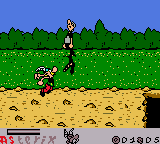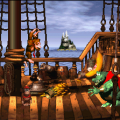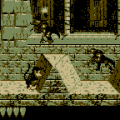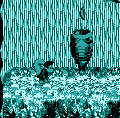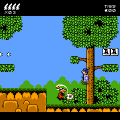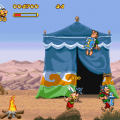- Asterix (Introduction)
- Astérix / Taz (Atari 2600)
- Obelix
- Asterix and the Magic Potion
- Asterix and Obelix: The Odyssey
- Asterix and the Magic Cauldron
- Asterix at Rahàzade
- Asterix: Operation Getafix
- Astérix (Arcade)
- Astérix (SMS)
- Astérix (NES/GB/SNES)
- Astérix and the Great Rescue
- Astérix and The Secret Mission
- Astérix and the Power of Gods
- Asterix: Caesar’s Challenge
- Astérix & Obélix: Die Suche nach dem Schwarzen Gold
- Astérix & Obélix Take on Caesar
- Astérix: Search for Dogmatix
- Astérix: The Gallic Wars
- Astérix Mega-Madness
- Asterix & Obélix Bash Them All
- Astérix & Obélix
- Astérix & Obélix XXL
- Astérix & Obélix XXL 2
- Astérix at the Olympic Games
- Astérix & Obélix Encounter Cleopatra
- Astérix: These Romans Are Crazy!
- Astérix: Rescue Obélix / Astérix and the Vikings / Astérix and Cleopatra
With the strong sales of Astérix merchandise across all Europe, it was only natural that we were now going to see a more steady flow of new video games being produced to take advantage of the revived interest the license was getting. While the movie license was owned by Cryo, who would do very little effort to capture any excitement with their products, Infogrames was developing and publishing a wide range of titles that all would play very differently. UK developer Rebellion was mostly in the business of making cross platform ports, but for Infogrames they developed an all new adventure. The game would see a release in Germany in late 1999 just in time for Christmas, but strangely was not released until May of 2000 for the majority of Europe.
Astérix: sur la trace d’Idéfix (Astérix: Search for Dogmatix) is a good ol’ platformer. Idéfix is a fan favorite in the Astérix universe, and while his roles in the various adventures may be miniscule in terms of importance to the plot, he is featured in nearly all scenes, panels and merchandise. It was especially with young kids that the little dog had found a following so in the early 1970s, a line of Idéfix books starting coming out. These books were handled outside of the team of Goscinny and Uderzo and had therefore a much different style to them in terms of storytelling, dialogue and to some extent the art style. These books were not popular nor successful and are not given much attention by fans today, but one of them was Idéfix au cirque (Idéfix at the Circus), which serves at the storyline. With the news of a circus rolling into town, Idéfix becomes curious and befriends a dog from the circus which tells him of the exciting life that comes with it. Idéfix runs away from Obélix in order to pursue a life with the traveling act, and so the duo sets out to find their little companion. While not highly regarded, it’s probably the best out of the Idéfix series. Like many other Astérix games, this one also takes bits and pieces from various adventures to mold a full game out of it, but the two main stories it uses are the Idéfix au cirque book and Astérix et la surprise de Caesar (Astérix versus Caesar) movie.
The game takes place over 6 different chapters, which take place at different places in the Roman empire, requiring you to visit the familiar locations like Egypt and Rome itself. Each chapter has a world map which will always offer the same different spots to visit. There are 3 stages, 1 boss stage, the inn and a minigame area. The game is progressed the same way on each map, you select the level of choice and search for a key. There is 1 key per stage, and the boss area requires 3 keys to be opened up. Each stage features one of three gameplay structures – run away from oncoming dangers in a chase sequence, explore a larger sized level or simply beat up the Romans and find items along the way. On the map, you can select either Astérix or Obélix, who each have their strengths and weaknesses. Astérix is fast and jumps high and far, but has very weak attacks while Obélix has tremendous strength but little mobility compared. Astérix can also crawl and reach places Obélix can’t, and vice versa as Obélix lets you walk through walls. Your choice actually matters quite a bit depending on the stages and requires you to think a bit what is best on that particular level, the strength or the speed. The only stages where you have no choice are the chase stages, where the game forces you to select Astérix, as he is the only character fast enough to get away. As you progress in the game, you will find yourself encountering new kinds of stages in the last stretch of the game like the magic carpet ride or chariot race in the colosseum. You can do the stages in any order, giving you a bit on nonlinearity to mix.
The inn serves a different purpose. Here you will find the choice of 3 options – refill your energy, buy a password or get hints. The inns are run by Panoramix himself and you are often required to go back here after each stage to refill your life bar, as roasted boars are quite a rare find, nor do they replenish much health. Buying a password is also a must to keep your progress safe and storable. The hints are generally quite mediocre and provide little to no help, with such insightful wisdom as “You need keys to unlock the door” being repeated quite often. On every stage you will find a variety of items. Golden coins are used at the inn so picking them up is essential, while you will also find red glowing letters scattered around. These letters are tied to the mini game stage you will find locked on the map. By finding all the letters to spell your character’s name over the 3 stages on your current map, you will gain access to these mini-games. These range from simple memory games to a Duck Hunt clone. Winning these games will give you a nice coin bonus which comes handy after some difficult stages. After unlocking these mini-games, they can be accessed in the Instant Fun option at the title screen. There are also magic potions which Astérix can pick up for temporary star power which comes in handy. Interestingly enough, if Obélix picks these up, you will lose energy and he will get sick, which is a nice little detail. The level layout is in general quite strong, with plenty of secrets to be found in the skies and lots of inter activity, from balancing over logs to bouncing on ropes to reach new areas.
Being released generally late in the Game Boy Color’s life, these game really takes use of every inch of power the handheld has to offer. The graphics look absolutely amazing in motion and is one of the prettiest games offered on Game Boy Color. The backgrounds are detailed, varied and filled with bright colors and the sprite work is second to none. Both Astérix and Obélix are animated with attention to detail, having them move very distinctly like their comic book and movie counterparts, and they are filled with details. They way they punch, walk, jump, even get hurt, are done with a lot of attention to details. As Astérix is generally weaker and has shorter reach with his punches, they have given him a long range attack where you can throw rocks from a distance, while Obélix can do a close range super punch which will even knock bosses away with just a couple of punches should you connect. Even though the sprites are at times massive, the layout of the level is always kept open while enemies are around so that you can clearly keep track on your surroundings, and not fall into any cheap death pits or other hazards because of the smaller screen. Graphically it shares a lot of similarities to Shantae, though that game would not see release until 2 years later. The cutscenes are all new and look fantastic and authentic despite being a 8-bit handheld title.
The music is another highlight to this title. Composed by Manfred Linzner, it owes a lot of its inspiration to the work Alberto Gonzales earlier provided to the other handheld offerings bearing the Astérix name. Linzner was a fairly well known demoscene member who would go on to slowly start composing music for commercial products. During his demoscene days he went under the alias Pink, and in the mid 90s he was one co-founders of Shin’en which is a German third party company. While they would at time develop their own games like Iridion, Nanostray and FAST on WiiWare, they acted as a sound developer for hire. Shin’en would code plenty of sound drivers for various consoles, and this game uses the GHX sound engine which allows for some very sophisticated sounds. Each area has their distinct themes, using upbeat and cheerful tunes for the more straightforward stroll areas and the hectic chases being accompanied with more frantic rhythms and desperate moods. Despite not being an very long game, there are tons of different songs and it always manages to reflect the game while on their own being strong melodies in composition. The sound effects are also really crisp and fitting of their intended action.
The sun doesn’t shine on all sides of the game despite its general high quality. The biggest gripe is the fact that if one loses during a stage, then you have to start over again on that map, which is quite annoying when you have already aquired 2 keys, and, for example, the chase stage takes you by surprise and kills you in an instant. A number of enemies cannot be defeated which means you have to avoid them completely, which is not always an easy task. In particular you’ll find this problems with the birds, which fly in specific patterns and always fairly low and somehow your jump never really manages to reach over them completely. Sometimes the choice of character can really come back to bite you halfway, where an onslaught of Romans come towards you, and if you are Astérix, just murder you.
Still, this is one fine choice if you are looking for a platformer on Game Boy, and really one of the most solid titles in all of Astérix’s long video game history. While the stages can sometimes feel repetitive, at least the game lets you select in which order you are to play them. Graphically and musically, you’ll be hard pressed to find a better product than this in all of Game Boy Color’s library.
